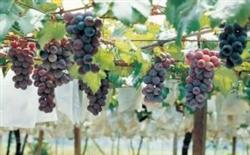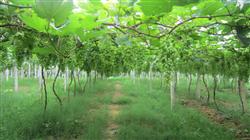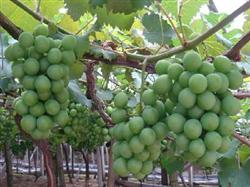Management techniques of grape ripening period

The main results are as follows: 1. When picking grapes in batches at the right time, the grape varieties are different and the ripening period is different. Different measures should be taken according to different conditions. Ripe grapes have a glossy surface, transparent pulp, a thick layer of powder, flavor, and brown seeds. If the fruit is picked too early, the acidity will be too high; if it is picked too late, the fruit will taste light and is not resistant to storage and transportation. Therefore, timely picking and batch picking is the key to ensure the quality of grapes. It is most suitable for picking after dry dew in the morning on a sunny day. 2. Pay attention to drought prevention and cooling. In the picking stage, in case of long-term high temperature or no rain, particles and leaves are easy to shrink, affecting plant growth and flower bud differentiation. Therefore, grass mulching between rows can be used to reduce the ground temperature, and attention should be paid to timely and appropriate irrigation. The ring ditch irrigation method should be used for irrigation. 3. Apply "nourishing body" fertilizer at the right time. The ripening and picking stage of grape is the second peak period of its root growth, so it should be fertilized in time. The amount of fertilizer applied this time accounts for 60% of the total amount of fertilizer applied in the whole year; the fertilizer should be organic fertilizer such as stable manure, compost, pond mud and so on. At the same time, some quick-acting fertilizers such as urea and bicarbonate are mixed. It is required to apply 3000-4000 kg organic fertilizer per mu, mixed with 30-40 kg urea or 100-130 kg ammonium bicarbonate, first apply chemical fertilizer, then apply organic fertilizer, then cover the soil, and irrigate in time after fertilization. In addition, the pruning of secondary shoots should be stopped during the mature picking period.
- Prev

Summer Management of Grape
There are many diseases in some vineyards in summer, such as grape downy mildew, white rot, anthracnose and so on. Downy mildew can cause fallen leaves, withered branches, rotten fruit and even death. Therefore, Liu Zhongtang, an agronomist of Weixian Agriculture and Animal Husbandry Bureau, reminded the broad masses of fruit farmers in the rainy summer season during the technical training in the township.
- Next

Scientific use of grape ripening agent ethephon
1. Pay attention to watering the easily cracked fruit varieties so that the soil will not be dry before the fruit expands, so that the pericarp will not age, and the cracking will be reduced when the soil moisture is too much in the rainy season. 2, it is recommended to bag the grape when there are conditions. The bagged grape pericarp is fresh and tender and flexible, and it is not easy to crack the fruit when it expands quickly in the event of rain.
Related
- Moge, come on! The staff of the peasant association in the producing area of cantaloupe were frightened when the crowd gathered.
- Causes and Solutions of low Fruit setting rate of Apple
- Symptoms and control measures of passion fruit virus disease
- Fruit growing lesson: how do apple orchards keep high yields?
- Can you build orchards in the mountains? What are the pros and cons?
- How to manage the coloring period of Crisson grape?
- This paper introduces the processing technology of two kinds of fig products.
- How much is a month for retired teachers in rural areas by 2020?
- How can strawberry planting increase sugar content? We should pay attention to management in many aspects.
- What are the cultivation techniques on how to improve the yield of golden fruit?

